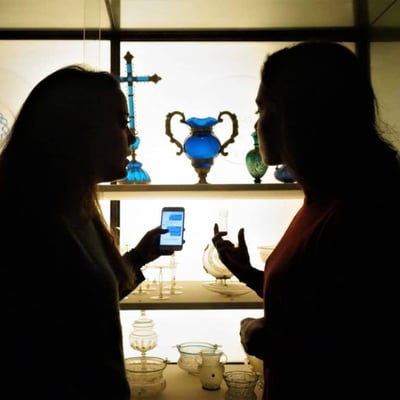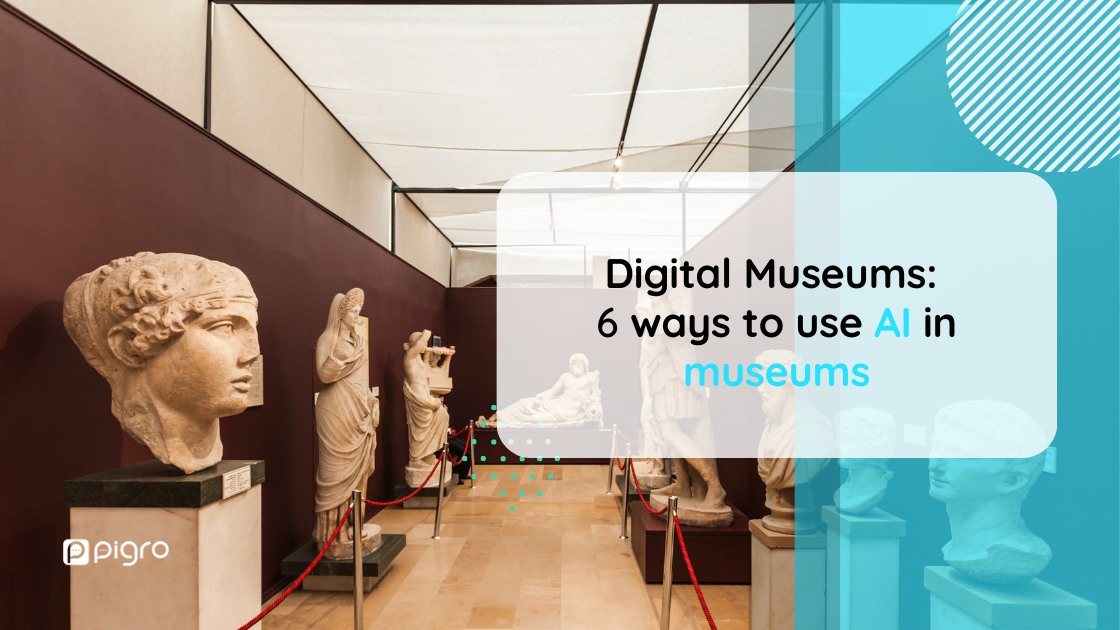Digital museums and virtual tours
For some time now, museums and galleries have been trying to find alternatives to “traditional” fruition by resorting to technology.
Initially, the aim was quite simple: to try to increase the amount of extra content, accessible through the use of tools such as QR codes or by replacing the classic audio guides with apps to be downloaded onto smartphones.
Later, interactive rooms were born to offer experiences in direct contact with the work, and didactics began to make use of tech tools, creating interactive museums.
However, experimentation between art and technology seemed to proceed very slowly until the early 2020’s when museums, no longer able to offer the possibility of physically visiting exhibitions, began to develop alternatives.
The immediate response was an increase in content on social media and the opening of other channels (the most striking example was the arrival of the Uffizi Gallery on Tik Tok, used mainly by teenagers), but they soon proved insufficient.
Increasing the need for more and more tech and cutting-edge solutions, Artificial Intelligence is also starting to be used within digital museums, with multiple purposes: speeding up the work of employees, enriching the experience of visitors, and providing more information to scholars.
What about the Exciting World of Conferences & Exhibitions?
AI Conferences & Exhibition - Immerse Yourself in the Cutting Edge of AI Technology
In today's rapidly evolving world, staying up-to-date with the latest advancements in AI technology is crucial. AI conferences and exhibitions provide the perfect platform for professionals, researchers, and enthusiasts to come together and immerse themselves in the cutting edge of AI technology. These events offer a unique opportunity to learn from industry leaders, discover groundbreaking innovations, and network with like-minded individuals.
Attending AI conferences and exhibitions allows participants to gain valuable insights into the latest trends and developments in the field. From keynote speeches by renowned experts to panel discussions and workshops, these events offer a comprehensive overview of the current state of AI technology. Participants can learn about the latest breakthroughs in machine learning, natural language processing, computer vision, and robotics, among other areas.
One of the key benefits of attending AI conferences and exhibitions is the opportunity to witness live demonstrations of state-of-the-art AI technologies. From autonomous vehicles to smart home devices, attendees can experience firsthand how AI is transforming various industries. These interactive demonstrations not only showcase the capabilities of AI but also inspire attendees to think creatively and explore new possibilities.
Moreover, AI conferences and exhibitions provide a platform for networking and collaboration. Participants can connect with industry professionals, researchers, and entrepreneurs, fostering new partnerships and collaborations. These connections can lead to exciting opportunities for further research, innovation, and business ventures.
In addition to the technical aspects, AI conferences and exhibitions also delve into the ethical and societal implications of AI technology. Panel discussions and debates explore topics such as privacy, bias, and accountability, ensuring that attendees gain a holistic understanding of the challenges and opportunities associated with AI.
As the demand for AI professionals continues to grow, attending AI conferences and exhibitions can also enhance career prospects. These events provide a platform to showcase skills, exchange knowledge, and connect with potential employers. Participants can explore job opportunities, attend career fairs, and engage in networking sessions specifically designed for AI professionals.
Returning to the Intersection of Museums and AI: Harnessing the Power of Artificial Intelligence in the Digital Museum.
Museums and the global crisis
From the beginning of the covid-19 pandemic, it was immediately clear to everyone that alternatives to traditional cultural tourism needed to be found. It was clear, therefore, that this global event would act as a watershed with what came before and what would come after, including the visitor experience.
This is demonstrated by data from UNESCO, in its publication “Reflecting on the crisis: world Heritage places, museums and heritage interpretation”, which reported that in 2020 public access to World Heritage sites was entirely or partially closed in 90 per cent of countries.
The report published in May 2020 revealed that 90% of the estimated 95,000 museum institutions worldwide had been affected by the temporary closures, including those associated with World Heritage sites. These museums depended mainly on the income generated by visitors and they would not be able to reopen.
That’s why World Heritage properties have developed innovative approaches in response to the global health crisis that were launched on websites and through social media.
When people realized that the immobility of the period was going to be prolonged, a reversal was necessary: the processes of technicalization, which had already been underway for some time, were accelerated in order to find a quick alternative to physically going to exhibitions. It is no longer the user who goes to the museum, but the latter arrives directly at home.
So-called digital tourism has had a considerable boost thanks to the proliferation of virtual museums and digital platforms that have made it possible to see works on smartphones, visit online galleries on one's own PC and even move freely within a museum directly from the couch at home, with virtual museum tours (as we will see later).
AI and Customer Experience: Transforming the Way We Interact with Museums
Artificial intelligence (AI) has revolutionized various industries, and the museum sector is no exception. With the global pandemic limiting physical access to museums, AI has played a crucial role in enhancing the customer experience and ensuring that art remains accessible to all. In this blog post, we will explore how AI is transforming the way we interact with museums, making art more engaging and immersive than ever before.
One of the most significant advancements facilitated by AI is the use of virtual reality (VR) for museum tours. VR technology allows visitors to explore exhibition halls and view artworks from the comfort of their own homes. Through realistic simulations and 360° virtual tours, individuals can experience the feeling of being physically present in the museum. This immersive experience is further enhanced by AI-powered audio guides, providing detailed explanations and insights about the artworks.
In addition to VR, chatbots and gamification have become popular tools for enhancing guided tours. Instead of relying solely on human guides, museums are employing AI-powered chatbots to engage visitors and create interactive experiences. These chatbots act as virtual guides, leading visitors on treasure hunts and encouraging them to observe artworks more closely. By combining gamification elements with art historical knowledge, museums are making the visit more enjoyable for younger audiences and fostering a sense of curiosity and exploration.
AI has also paved the way for improved accessibility in museums. Humanoid robots, like Pepper, have been deployed in various museums to facilitate communication and share knowledge with visitors. These robots can answer questions, tell stories, and overcome language barriers, making art and culture more accessible to international visitors. By leveraging AI capabilities, museums are breaking down barriers and ensuring that everyone can engage with art, regardless of their linguistic background.
Moreover, machine learning and neural networks have proven invaluable for scholars studying artworks. Museums, such as the Norwegian National Museum, have utilized these technologies to add metadata and categorize paintings based on motifs, styles, and compositions. The organization of collections and catalogues is also benefiting from AI. Visual recognition algorithms can analyze vast amounts of data, tagging and sorting artworks to create more coherent collections and facilitate research.
AI's impact on museums goes beyond organization and accessibility – it can even give voice to artworks. The São Paulo Art Gallery in Brazil has implemented an AI system called "IBM Watson" to provide visitors with the opportunity to engage with artworks through conversation. Visitors can ask questions, seek information, and even have casual conversations with the AI, making art more approachable and inclusive to a wider audience.
In conclusion, the integration of AI in museums has revolutionized the customer experience, enabling virtual tours, interactive chatbots, improved accessibility, enhanced cataloging, and even giving voice to artworks. While the physical visit to a museum will always hold its allure, AI has opened up new avenues for engagement and made art more accessible to a larger audience. With continued advancements in AI technology, museums are poised to create even more immersive and personalized experiences for art enthusiasts worldwide.
Digital experiences in museums: pros and cons
Obviously, fruition “at a distance” brings with it positive and negative aspects: it is not possible to perceive, for example, what Walter Benjamin in his book - “The work of art in the age of its technical reproducibility” - defines as the “aura” of the work, just as it is not possible to interact with other visitors and the context.
At the same time, however, being able to see an exhibition online, from the comfort of one's own home, increases the number of possible users, for whom the creation of virtual museums may prove to be the incentive to come into contact with art.
Certainly, the main difference between an online museum and a traditional one is not being able to admire the original artwork, and having to deal with a reproduction of it.
But, although seeing original works in museums is our daily routine, in the past it wasn't always like this.
The director of the Uffizi Gallery, Eike Schmidt, in the 2021 TEDxBarletta explains how art has not only remained completely inaccessible after a year and a half of pandemic but also how in past decades it was difficult to approach for many social reasons because museums were conceived as an art history textbook: their use was dedicated to the few who understood a certain language and did not care to stimulate the interest of the wider public.
Therefore, the use of AI in museums, as we will see, could represent a tool to bring people closer to art that does not exclude “physical” fruition but offers new ways to enhance it.
But how is AI used in museums?
6 ways to use AI in museums
1. Virtual Reality for moving through the museum
Although virtual reality had already begun to take its first steps within the art sector, with the impossibility of moving around linked to the global pandemic it has had a strong rise.
How to make the visitor free to roam around the various exhibition halls while staying safe at home?
With the use of virtual reality, i.e. the realistic simulation of a reality that does not exist, it is possible to create 360° virtual tours. The virtual tour allows you to move among the works as you would in reality and listen to the explanation of the audio guide.
Among the institutions that first decided to invest in virtual reality is the Dali Theatre Museum, which uses artificial intelligence and machine learning to create a virtual reality environment where visitors are welcome.
Through the use of the Matterport platform, it is possible to enter the virtual museum and move around freely, being able to enjoy in-depth information and curiosities about the works.
2. Chatbot and gamification for guided tours

Credits: Case Museo di Milano
The guide, inside the museum, is in charge of explaining the works to visitors, making them curious and answering questions.
And what if all this was done by a chatbot? This is the idea that InvisibleStudio had for Le Case Museo in Milan.
Giuliano Gaia, the co-founder with Stefania Boiano of InvisibleStudio, said that "Unlike other museum chatbots, ours is exclusively a game, a treasure hunt within the collections. In this sense, it's the chatbot that asks the visitor questions, 'forcing' them to carefully observe the collections and discover unexpected details".
Through digital innovations such as gamification and storytelling, they have tried to make the museum visit more interesting in the eyes of young people, combining art historical knowledge and learning, typical of guided tours, with the curiosity of the treasure hunt.
3. “Museum robots” to improve accessibility
Pepper is a humanoid robot that has been developed by the French company Aldebaran Robotics, and was placed in three Washington-based museums of the Smithsonian (including the National Museum of African Art and the National Museum of African American History and Culture), with the purpose of improving linguistic communication to share knowledge about culture, art and science efficiently to the visitors.
Pepper was answering visitors’ questions and telling stories using its multi-lingual skills, gestures, and an interactive touch screen, to eliminate the language roadblock for international visitors.
4. Machine learning and neural networks to help learners
AI in museums and galleries is not only being used to make the experience better for visitors but also to help scholars.
As happened at the Norwegian National Museum, where exploiting machine learning and neural networks, they managed to add meta-data to the paintings of the collections that could prove very functional, especially for those who study them.
The T-SNE algorithm groups images by the similarity of motifs, technique, composition and use of colour, creating a user interface of the museum's web page with the works divided into five categories: paintings (by motif), paintings (by style), prints, drawings, and design.
5. AI to organize catalogues and collections
Among the various departments of museums, a sector is dedicated to the organization of collections and catalogues.
This means having to carry out an in-depth study of the works to try to recreate connections not only within the collections themselves but also with others in the museum.
But what if this was taken care of by AI?
According to the AAM (American Alliance of Museums), “AI will be an essential tool for museums managing the massive scale of data in the 21st century. … Visual recognition algorithms can unlock the potential of digital image collections by tagging, sorting, and drawing connections within and between museum databases.”
For an artificial intelligence algorithm, it is in fact extremely simple to recognize recurring visual or chromatic elements, associate them with a current or an artistic expression and thus create more coherent collections and catalogues.
6. AI to give voice to works
We've seen how AI can aid fruition by enriching it with notions and details that help both scholars and visitors.
But that's not all. AI can even give voice to the artworks.
That's what the São Paulo Art Gallery in Brazil has done, thanks to the use of the AI system “IBM Watson,” based on self-learning.
Born with the idea of bringing people who are not used to visiting museums closer to art, it offers the possibility to ask questions of any kind, even the most trivial, without the fear of being judged.
This is how “A Voz da Arte” was born, a project that uses artificial intelligence and voice recognition to give, literally, voice to selected works of art.
Artificial intelligence can be used in various ways within museums and galleries. The combination of art and technology allows us to broaden our experience and take collections and works outside of museums.
The digitisation of cultural assets certainly favours their “democratisation”: their fruition is in fact increasingly within everyone's reach, arriving directly inside our homes, without the need to move or pay for a ticket. All we need is a device and an Internet connection.
Read also:
- Artificial Intelligence and creativity: AI that writes, paints and composes
- AI Podcasts: Top 5 podcasts on Artificial Intelligence
Want to know more about Pigro? Contact us!



